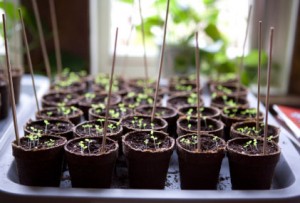by Kim Wilhelm and Bryan Jones of Sweet Corn Organic Nursery
Some mixes use perlite, which is fine, but I personally don’t like the amount of energy that is needed to explode the soaked cinder sand in the kiln. Besides, all the minerals and water-holding capacity is lost through this horrible process.
To make a good organic starting mix yourself, take 2 parts peat moss and 1 part black cinder sand, and mix very, very thoroughly. If you cannot find the black cinder, washed sand will work. We use a piece of equipment to do this mixing for us, but doing it by hand is fine as long as you do it thoroughly to where the pieces of peat are really small and the sand is incorporated throughout.
This soil-less mix is great to use to start seeds and when plants are very young and can be at risk for dampering off, which is a soil-bearing pathogen that can be difficult to fend off organically. (It CAN be done though, so write me if this happens). So, to minimize any risks of failure, use a soil-less mix to start your seeds.
(Note: because we have an organic nursery, we transplant our starts after 2 true leaves form into 6 packs that have organic soil, but it’s not necessary to transplant yours until 12 weeks. At 12 weeks though at that most, you should definitely transplant them into regular organic soil so that the microbes can benefit the plant and it can access a broader spectrum of nutrients.)
THE MOST IMPORTANT VARIABLES
Other than your soil, the most important things to ensure success in growing seedlings indoors is proper light, temperature, and moisture — along with one secret weapon: seaweed.
LIGHT
So how much light does a tomato, for instance, need to grow a sturdy healthy plant and not the spindly wimpy things that so many of my costumers have grown (I won’t name names ha ha ha)? The answer is: 8 to 10 hours of very direct light is ideal, but they can grow healthy in as little as 6 hours if they are placed in direct light and they are not getting a draft or cold blast from a leaking window. If your windows allow air through, you can put up a cold shield of clear plastic from the hardware store or simply some food wrap, but make sure you’re not cutting off the light.
OK, let’s say you don’t have a window that will work well (facing south is ideal), or that your wife will kill you if you get water on the windowsill or carpet. Don’t give up hope! I have a very easy and inexpensive way to pull this off. All you need is a wood bar like the one in your closest. I’m not saying you should use the one you have, but I did that years ago when I was a bachelor. (If you are married, I would suggest you purchase one from the hardware store instead of using the one holding your wife’s clothes!). Anyway, get your wooden bar and set it up in the heated garage or laundry room or wherever (before I had greenhouses, I grew anywhere I could).
Now, head down to the hardware store and buy one of those shop florescent lights that already have a plug attached. They are generally about $10.00, but find one you can tie some rope to. Place the rope around the wood bar so you can adjust the light up and down. There is only one spectrum of light that’s missing between shop florescent lights and the $100+ grow lights, and the plants don’t know the difference. Besides, in the case of tomato and pepper plants, which require a longer amount of time to grow successful starts than most other vegetables, they are only going to be under the light for 10 to 12 weeks. So, in this case, count backwards on your calendar 10 to 12 weeks from your last frost date and this will keep them at a minimum under artificial light. OK, this is the secret! Keep your florescent light bulbs only 2 to 3 inches away from the tops of the plants. As the plant grows, just keep moving the rope so the light is always at the right distance. I should caution you about electricity and water, so be careful that you don’t shock yourself when watering and use common sense when moving the light and tying it off when you have the height you want.
This method will keep the seedlings strong and sturdy and prevent a spindly plant.
TEMPERATURE
In terms of temperature, the most ideal temperature for growing seedlings indoors is 70-85 degrees (this is especially true with pepper seeds, as they will need very warm soil to germinate). An electric heater below the windowsill — or in close proximity to wherever you choose to grow — can also help with providing heat if needed.
MOISTURE
I plant my seed only 1/8 inches deep, just barely covering them, and then I mix one teaspoon or one cap per gallon of MegaSea and water it in. This will act as a pre-soak and will help promote germination.
Continue to water with the seaweed solution, always making sure to not let the soil dry out completely but don’t overwater either, until the seed has sprouted. Once it has sprouted, water with regular water (as needed) for the next 6 days, and then with MegaSea again on the 7th day.
Continuing water with this method each week. Basically, you want to give it seaweed every 7 days, and then water in between as needed, when it’s almost dry but not completely dried out.
There is so much to say about seaweed that I could (and will) write an entire article about it, but basically as it relates to sprouting seed, it is a really effective SECRET WEAPON! It is a wonderful, 100% organic product that not only helps improve germination, but also has a natural growth hormone in it that promotes rapid root growth. It will also help offset some less-than-ideal variables with watering and temperature, and it works very well on old or hard-to-sprout seed.
ONGOING AMENDING AND FERTILIZING
As far as soil amendments go, don’t fertilize until at least two true leaves are forming, which in the case of tomatoes and peppers, will generally be 4-5 weeks after planting.
One common misconception is that seeds should be fertilized immediately; however, Mother Nature did a wonderful thing by putting everything that the seed needs to prosper inside the seed itself. Further, nitrogen can actually help set up a situation for pathogens to breed, so by NOT fertilizing in the very beginning, you are actually helping the plant and giving it the chance to reach infancy.
Earlier I said to use seaweed immediately, so wanted to clarify that seaweed is low in nitrogen, and the growth properties it has offsets any of the risks. Plus, it is actually a disease-preventer because it will raise the sugars to help fight off disease and pathogens. And again, it promotes rapid root growth and that’s what you are really after.
So, again, it’s unnecessary to fertilize until two true leaves form. At that point, it’s past the most critical time and they are old enough that you can safely give them some fish emulsion, which will supply them with the nitrogen they need. I only use fish emulsion that is a hydrolyzed type like Sweet Garden Organic’s MegaFish or Neptune’s Harvest brand. Most other brands have the protein removed to make animal feed and the oil to make makeup, and they are really inferior products.
DO NOT USE CHEMICALS, as this will weaken your plant and destroy your soil, especially if you are planning to grow organically. If you do, it’s like you’re setting up a death zone in your garden. This is the main reason I started to grow my own starts. It just didn’t make any sense to me to buy a chemically-grown store bought seedling that would end up ruining hard work and time and money that I had put into building my organic soil.
The other advantage of growing your own starts is that the skies are the limit on what you can grow! There are thousands of heirloom and other wonderful varieties you can grow that you will never find in nurseries as seedlings.
I hope this information was helpful. If I can be of any help, please visit sweetcornorganicnursery.com, click on the “Ask Bryan” button to send me your question, and I will get back to you shortly.
God Bless and Happy Gardening. And remember to “Feed The Soil, Not The Plants.”
Bryan
(Note: when this article references 10-12 weeks, we are using tomato and pepper plants as the example, since they are some of the longest vegetable plants to sprout and grow. Timing could be less than 10-12 weeks for tomatoes and peppers if soil temperature is increased with an electric grow propagation system or heating mat, which could decrease the total time to 6-8 weeks. Also, while these growing instructions apply to most vegetable and herb seeds of any kind, timing will obviously vary depending on what is grown. We will be writing more on this in the future).










0 Comments